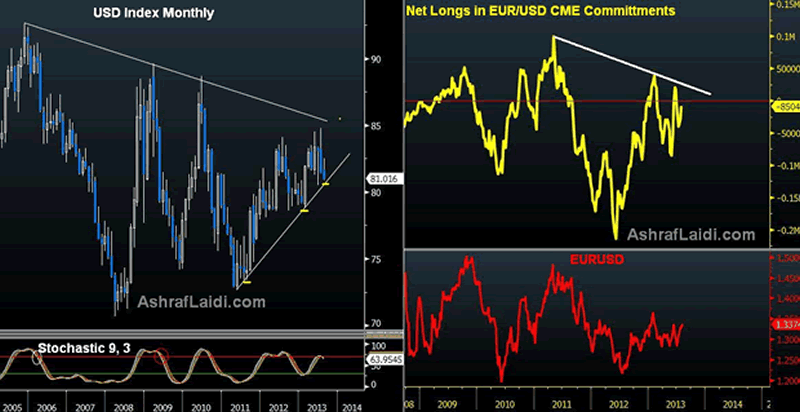U.S. Dollar - Time to Worry?
Currencies / US Dollar Aug 10, 2013 - 05:34 AM GMTBy: Ashraf_Laidi
 Four weeks ago, the USD index hit 3-year highs, metals licked their wounds from the biggest decline in decades and the US growth story stood out in the headline. The Fed was considered the only major central bank capable of scaling down its quantitative easing, while the ECB mulled cutting interest rates to zero. The greenback was boosted by a powerful combination of fundamental and technical moving in tandem.
Four weeks ago, the USD index hit 3-year highs, metals licked their wounds from the biggest decline in decades and the US growth story stood out in the headline. The Fed was considered the only major central bank capable of scaling down its quantitative easing, while the ECB mulled cutting interest rates to zero. The greenback was boosted by a powerful combination of fundamental and technical moving in tandem.
But all changed in June when the Fed reminded that any tapering of asset purchases would not necessarily tighten monetary policy as persistent growth in the Fed's balance sheet would help maintain liquidity driven in the markets.
The Fed's statement was not isolated. Signs of stabilization in the business surveys of the Eurozone and the UK PMIs as well as market scepticism with Japan PM Abe's "policy arrows" conspired to rebalance the flows in currency markets.
The timing of the aforementioned dynamics is never a coincidence. From a charts perspective, the greenback had tested an 8-year trendline resistance (see chart), EURUSD tested a 12-month trendline support and the yield on the US 10-year government note tested its 6-year trendline.

Levels to Watch
The list of explanations can go further and so do the plausible scenarios for a continuation of the USD's downtrend as well as its recovery. As it stands, we expect further strength in both the yen and sterling against the USD into the rest of the month until the USD index retests its 2-year trend support at 80.40-45. This implies an equivalent resistance near $1.3450s and $1.5660s in EURUSD and GBPUSD respectively.
Policy/Data to Watch
Once those currency parameters are attained, the commentary from the Fed will once again be scrutinized as we near the revision of: 1) US Q2 GDP; 2) the release of the August jobs repor; 3) the Fed's annual symposium in Jackson Hole and; 4) more clarity on the race for Fed successor between Janet Yellen and Lawrence Summers, all of which will take place in the final week of August/early September. The fundamental scenarios for a break in USD support could well include a lower than expected tapering of the $85 bn in asset purchases, or no tapering at all in September but only a mild announcement for December. And do not discount the role of the obligatory article from Wall Street Journal's Fed watcher Jon Hilsenrath, whose effectiveness in steering bond and FX markets has returned after a temporary lull late last year.
On the fiscal side, FX traders will closely watch President Obama's corporate tax reforms and the possibility of slashing taxes on US multinationals' foreign earnings. When Bush introduced similar reform in 2004 as part of the Homeland Investment Act, the dollar had a powerful year resulting from US multinationals repatriating nearly half a billion dollar to qualify for the tax holiday in 2005.
We have not covered non-US factors, which could stem the tide of USD-negative FX flows such as; negative surprises from China's macro data/money markets; rising pre-election tensions in the camp of German Chancellor Merkel and unforeseen finance shortfalls from the sovereign obligations of Southern Eurozone nations. These are the factors to watch and the levels to scrutinize.
For tradable ideas on FX, gold, silver, oil & equity indices get your free 1-week trial to our Premium Intermarket Insights here
For more frequent FX & Commodity calls & analysis, follow me on Twitter Twitter.com/alaidi
By Ashraf Laidi
AshrafLaidi.com
Ashraf Laidi CEO of Intermarket Strategy and is the author of "Currency Trading and Intermarket Analysis: How to Profit from the Shifting Currents in Global Markets" Wiley Trading.
This publication is intended to be used for information purposes only and does not constitute investment advice.
Copyright © 2013 Ashraf Laidi
Ashraf Laidi Archive |
© 2005-2022 http://www.MarketOracle.co.uk - The Market Oracle is a FREE Daily Financial Markets Analysis & Forecasting online publication.



